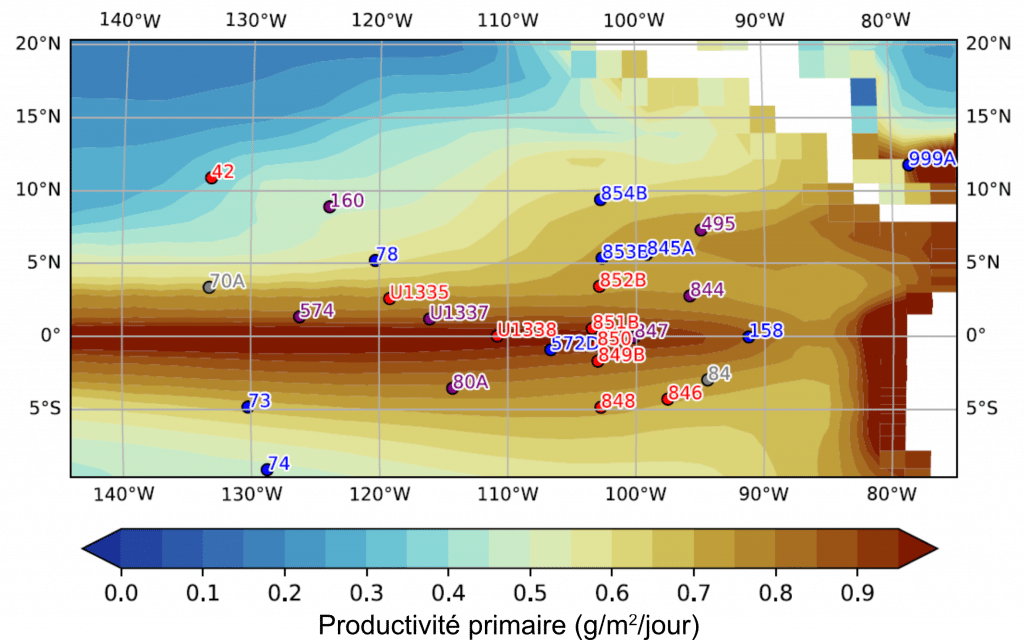- Home /
- Science /
- Climate /
- Climate projects /
- ANR JCJC MioCarb /
ANR JCJC MioCarb
The project MioCarb aims to understand how the modern carbon cycle operates between the end of the Miocene and the beginning of the Pliocene (10-4 Ma), a period of global climate change.
Indeed, in this time interval, a global decrease in temperature and an increase in the latitudinal temperature gradient of marine surface waters are linked to a strong decrease in atmospheric CO2 concentration. Between 9 Ma and 4 Ma, an increase in carbonate and siliceous oceanic sedimentary fluxes called Biogenic Bloom is observed synchronously with this climate change.
Pelagic carbonate production - an important system in the carbon cycle - results mainly from the activity of calcareous nannoplankton, photosynthetic algae producing micrometric calcareous plates of which coccoliths are a part. Biogenic bloom is therefore characterised by an increase in the rate of accumulation of calcareous nannofossils.However, a change in the macroevolutionary dynamics of calcareous nannoplankton marked by a decrease in their diversity and a decrease in the size of nannofossils is also observed in this time interval. A series of important macroevolutionary and biogeochemical modifications therefore took place in a few million years during the transition of the carbon cycle in the Upper Miocene-Lower Pliocene. The MioCarb project seeks to understand the origin of the Biogenic Bloom and its impact on the carbon cycle.
In order to answer these questions, several complementary approaches will be implemented in the form of three research axes:
- The quantification of calcium carbonate and organic matter accumulation rates, as well as calcareous nannofossils, taking into account their abundance and mass in 10 oceanic boreholes. This part of the project will use methods for quantifying CaCO3 by automated calcimetry and TOC by elemental analyser. The quantification of the absolute abundance of calcareous nannofossils and their mass is based on the acquisition of an automated optical microscope and the use of the artificial intelligence coccolith recognition system (SYRACO) developed at CEREGE. This study will therefore assess the impact of macroevolutionary and palaeoceanographic changes on pelagic sediment production during the Biogenic Bloom.
- Quantifying calcium carbonate accumulation rates on a global scale over a set of ocean boreholes. This part of the project will focus on exploring the abundant data from ocean drilling campaigns and using recent reconstructions of ocean basins by the Australian EarthByte team. It will also quantify the evolution of the CCD and, above all, the pelagic sediment budgets and the quantity of carbon buried during the Biogenic Blooms. . the study by climate modelling, taking into account the specific climatic, biological, sedimentary and geographical features of the late Miocene, in order to identify the origin of the Biogenic Blooms and their impact on the carbon cycle.
This project is led by a multidisciplinary scientific team composed of micropalaeontologists, palaeoceanographers, sedimentologists, climate modeller, automated optical microscopy engineer and micropalaeontology laboratory technician from CEREGE, AMU and the University of Sydney.
2022-2025: ANR JCJC MioCarb
CEREGE lead : Baptiste Suchéras-Marx
The Mio-Pliocene transition: setting up the modern carbon cycle
Partners CEREGE, AMU
Foreign collaborators: University of Sydney


